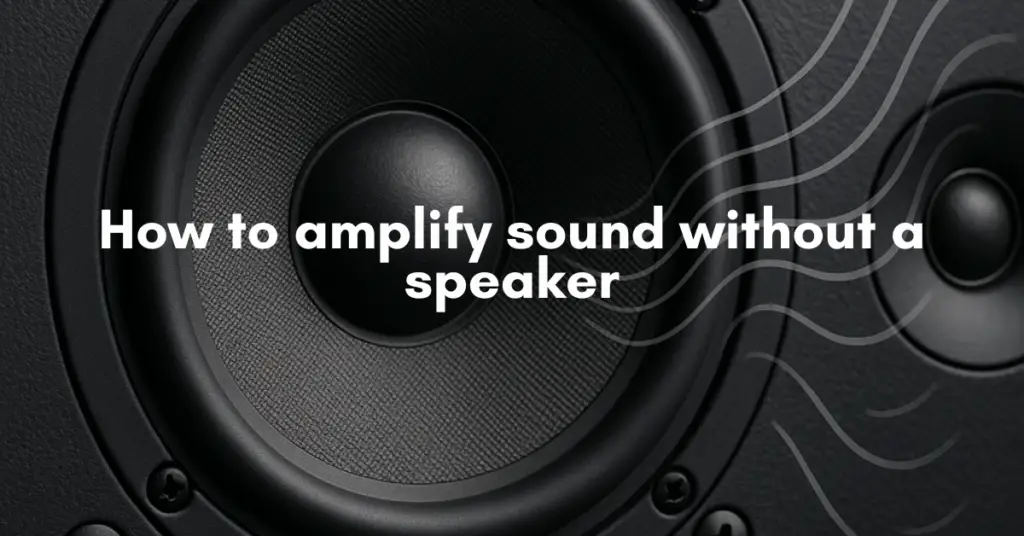Amplifying sound without a speaker is fully possible by using physical acoustics rather than electronic components. Long before modern speakers existed, people relied on natural resonance, mechanical vibrations, and horn-shaped structures to make their voices and instruments carry farther. These same principles can still be used today to boost the volume of a smartphone, musical instrument, or any other sound source. The key is to increase how much air the sound source moves and how efficiently the sound waves are projected.
Use Natural Resonance to Boost Volume
Resonance is one of the most effective ways to make sound louder without using a speaker. When a sound source causes another object to vibrate at the same frequency, the second object amplifies the sound by acting as a larger vibrating surface. Placing a quiet device on or against materials such as wood, metal, or plastic can noticeably increase its loudness because those materials carry and spread vibrations more effectively. A hollow wooden box, a tabletop, or even a guitar body can become a passive amplifier simply by transmitting the sound source’s vibrations.
Increase Vibrating Surface Area
Small sound sources move very little air on their own. By transferring their vibrations into a larger surface, you multiply the amount of air being pushed, which increases volume naturally. This is the logic behind acoustic instruments like violins, guitars, and drums. To do this at home, place the sound source directly against a surface that can vibrate: thin wooden boards, plastic containers, glass panels, or metal sheets. The larger the surface area and the lighter the material, the more sound it can produce.
Use Horns and Funnel Shapes to Project Sound
Horn-loading is one of the most efficient ways to amplify sound without electronics. A horn or funnel works by concentrating and directing sound waves from a small opening to a larger one, improving the transfer of acoustic energy into the air. Examples include megaphones, trumpet-like shapes, gramophone horns, and rolled-up hollow cones made from paper or cardboard. When you place a sound source at the narrow end of the horn, the shape guides and strengthens the sound as it exits the wide end, making it noticeably louder and more focused.
Create or Use Passive Acoustic Chambers
A passive acoustic chamber is an enclosed shape that captures sound inside and then directs or boosts it as it exits. Bowls, cups, jars, wooden boxes, and ceramic pots can all function as natural amplifiers. The curved interior reflects and focuses sound waves toward the opening, helping certain frequencies resonate more strongly. For example, placing a phone in a ceramic bowl or inside the opening of a paper towel tube creates a simple chamber amplifier that increases overall volume without needing any electronics.
Use Reflective Surfaces to Reinforce Sound
Sound becomes louder when it is directed toward hard, reflective surfaces rather than soft, absorbent ones. Hard materials like tile, concrete, metal, and glass reflect sound efficiently, increasing perceived loudness. Techniques include facing a hard wall while speaking or playing an instrument, placing a device in a corner to take advantage of boundary reinforcement, or positioning the sound source near a large flat surface that reflects sound outward. This method does not increase the actual energy but significantly enhances how loud the sound feels.
Optimize Positioning and Environment
Strategic placement can amplify sound more than many people expect. Sound sources placed near corners, inside curved surfaces, or close to flat reflective materials produce stronger projection. Elevating the sound source so it is not muffled by surrounding objects also helps. Even the angle of the sound output affects how far it travels. Pointing a source upward or toward a reflective surface can improve perceived loudness without adding any equipment.
DIY Tools for Non-Speaker Amplification
Many everyday items can serve as surprisingly effective amplifiers: a ceramic bowl, a glass cup, a plastic or metal tube, a paper or cardboard cone, a wooden box or drawer, a plastic cup with a cut-out slot, a large hollow container. These objects either add resonance, funnel sound, or focus the sound waves, all of which increase volume without needing a speaker.
Limitations of Non-Electronic Amplification
While passive methods can noticeably increase loudness, they cannot match the power of a modern electronic speaker. They depend entirely on the original vibration energy, meaning there is a limit to how loud the mechanical amplification can become. Additionally, passive amplification often emphasizes certain frequencies more than others, which can alter the sound’s tone. Despite these limitations, acoustic amplification remains highly efficient, simple, and practical for many everyday uses.
Conclusion
Sound can be amplified without a speaker by using natural resonance, expanding vibrating surfaces, directing sound with horns or funnels, placing the sound source in passive acoustic chambers, taking advantage of reflective surfaces, and optimizing its position in a room. These techniques rely on fundamental acoustic principles that humans have used for centuries and remain useful today for amplifying music, speech, or device audio without electronic equipment. With creativity and an understanding of sound physics, effective amplification is entirely possible—no speaker required.

